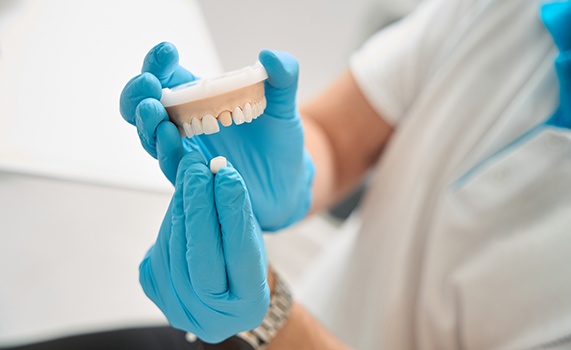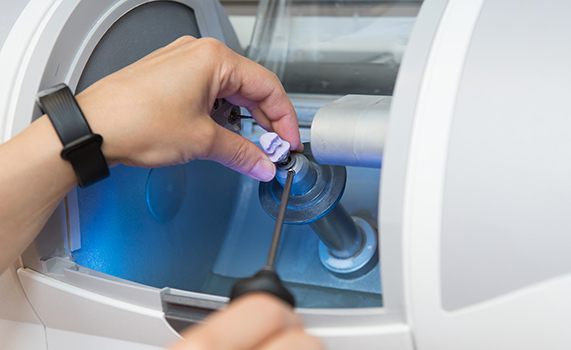Dental Crowns – Rowley, MA
A Lifelike Repair for Damaged Teeth

A decayed or broken tooth can detract from your daily quality of life in several ways. For example, it might hurt, become infected, or sustain additional injuries that make eating and speaking uncomfortable. Plus, you might feel self-conscious about how it looks.
Fortunately, Dr. St. Clair can provide a lifelike repair for damaged teeth by placing a customized dental crown to shield it from potential problems while improving its functionality and appearance. Continue reading to learn more about this treatment, and feel free to contact us for additional information.
Why Choose J. Peter St. Clair, DMD for Dental Crowns?
- Dentist With 30 Years of Experience
- 1-Day Dental Crowns Available
- Advanced Technology to Enhance Patient Comfort
What is a Dental Crown?

A dental crown is a tooth-shaped cap cemented over an injured tooth to allow you to continue using it normally. They’re made from durable materials, like cast gold, ceramic, or porcelain-fused-to-metal. Many providers default to porcelain restorations because the material reflects light like enamel and can be customized to match your natural smile to look as realistic as possible.
They are often used to:
- Protect damaged teeth.
- Prevent additional injuries.
- Restore a tooth that underwent a root canal.
- Anchor a dental bridge.
- Cover a dental implant to replace a missing tooth.
If your tooth is severely broken or unable to support a dental crown, our team might recommend an alternative solution, like extraction and replacement.
The Dental Crown Process

Before proceeding, you must schedule an initial consultation with Dr. St. Clair so he can verify that placing a dental crown is the best option for you. After his examination, he’ll discuss potential treatment plans with you based on his findings.
Depending on your circumstances, he might suggest a standard dental crown made of gold, known for its durability and resistance to erosion. First, he’ll apply a local anesthetic to keep you comfortable while he cleans the damaged tooth and removes decayed materials to disinfect the area. Next, he’ll make impressions and take images of your teeth and send them to a special dental laboratory to begin building your customized tooth-shaped cap. It can take a couple of weeks for the finished product to arrive, so we’ll fit you with a temporary crown to shield your grin in the meantime.
We also proudly offer ERD 1-Day dental crowns that allow us to examine and restore your tooth in the same visit. This involves cleaning it and making digital impressions using Planmeca FIT technology in the office that designs your custom-fitted prosthetic. Then, the information is sent to an on-site milling unit that carves your new tooth out of a block of color-matched ceramic for seamless results.
The Benefits of Getting a Dental Crown

There are several advantages to getting a dental crown in Rowley, such as:
- Improved comfort. This cover can shield your smile from the ache of trying to eat with an injured tooth.
- Restored bite force. This cap allows you to use your tooth normally so you can enjoy all your favorite foods.
- Versatile treatment. Whether you need a dental crown for functional or cosmetic purposes, it’s an excellent solution to restore your grin.
- Your restoration can last 10 to 15+ years with the right care.
- Easy maintenance. Preserving your new tooth is as easy as brushing and flossing twice daily and visiting our team for a routine checkup every six months.
Dental Crown FAQs
Are Dental Crowns Permanent?
Although they are not technically permanent, dental crowns are definitely a long-term solution. In fact, on average, they can protect your tooth from anywhere from five to fifteen years!
When Dr. St. Clair reshapes your tooth for a crown, that procedure is considered irreversible, because tooth enamel cannot grow back after it has been lost. Thus, that tooth will always need a crown for protection going forward.
That being said, dental crowns do protect your underlying tooth from additional damage, helping it to survive for much longer than it likely would have otherwise.
You can keep your dental crown in great condition for many years by taking excellent care of it with regular daily oral hygiene, dental check-ups, and wearing a mouthguard or bite guard if necessary.
Do Dental Crowns Get Cavities?
Technically it’s not possible for a dental crown to get a cavity; however, the tooth underneath it still can. In fact, a crowned tooth has about the same risk of decay as an uncrowned tooth.
Poor oral hygiene makes it possible for bacteria and plaque to form around the gumline, where the tooth meets the crown. They can then travel underneath the crown, wreaking havoc on the underlying tooth.
You can easily prevent cavities from developing on crowned teeth in the same way you’d prevent them in any other tooth: with daily brushing and flossing, and regular check-ups and cleanings from Dr. St. Clair.
Can Dental Crowns Be Whitened?
No, unfortunately, no matter what your dental crown is made of it cannot be whitened like your natural teeth can. This is because your real teeth have tiny pores in the enamel through which bleaching gels can enter and break apart stains. Dental crowns do not, and thus your crown should always remain the same color.
Metal-free crowns are designed to blend seamlessly with your surrounding teeth. To minimize the risk of your natural teeth becoming discolored and making your crown stand out in your smile, speak to Dr. St. Clair about getting your teeth professionally whitened before your crown is placed. This way, your crown will be matched to the ideal shade of your natural teeth!
How Durable are CEREC Crowns?
Same-day crowns aren’t made of metal, so they’re not as durable. However, they do offer similar protection and strength to lab-made ceramic and porcelain crowns.
Same-day crowns are typically made from a solid block of dental porcelain, which can not only mimic the natural appearance of enamel by reflecting light, but it’s also extremely strong.
A same-day porcelain crown could last between 10 and 15 years if you are careful to avoid smoking, maintain excellent oral hygiene, and don’t use it to crunch on hard items like ice cubes or hard candies.







